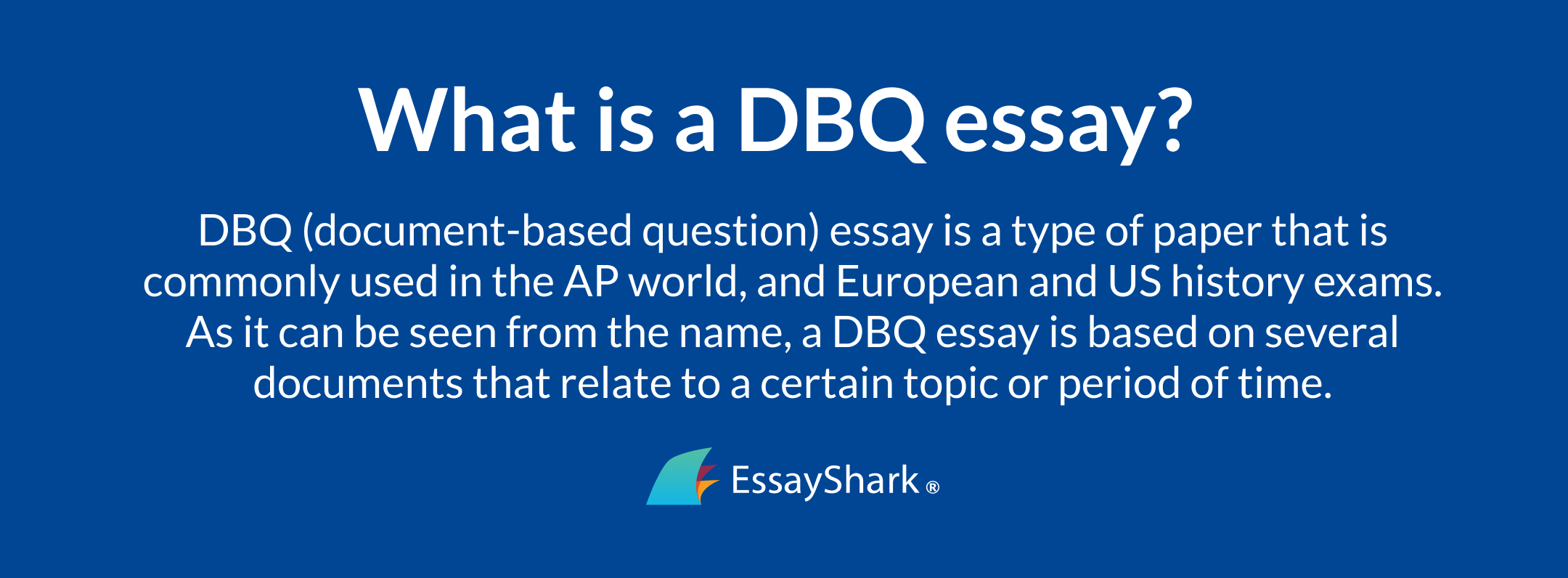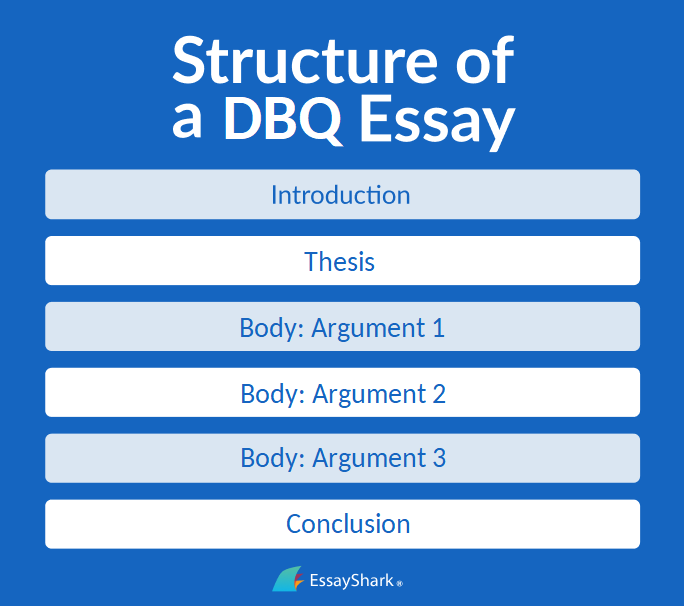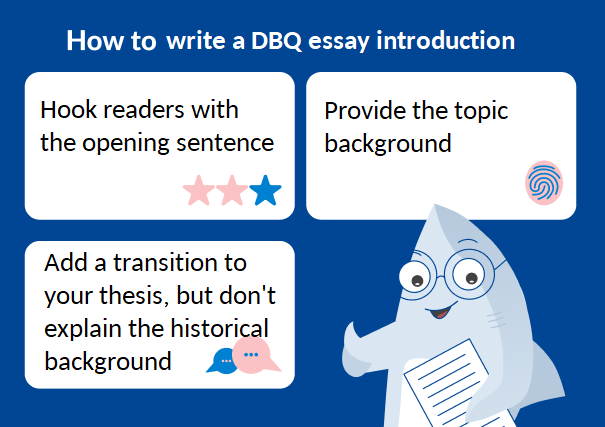In this guide, you’ll learn how to write a DBQ.
This task often dazes students, as they don’t face this type of essay in class. When the time comes to deal with it, many questions and doubts appear about how to write a DBQ AP world, how long should a DBQ be, how to structure it, and so forth.
How Long Should a DBQ Be?
You have 40-45 minutes to complete the DBQ essay. Aim for 5-6 paragraphs that will discuss at least half of the documents provided with the prompt. Use a double-spaced format for your essay.
If you write it by hand, keep it three pages long. As for the word count, your DBQ essay should be between 700 and 1000 words.
No worries:
We will go through the thorny path of DBQ essay writing together.
Table of contents
- How Long Should a DBQ Be?
- What Is a DBQ Essay?
- How to Write a DBQ Essay
- DBQ Structure
- Steps to Writing a DBQ Essay
- How to Write a DBQ Introduction
- How to Write a DBQ Thesis
- Writing the Body Paragraphs of Your DBQ Essay
- How to Write a DBQ Conclusion
- Little Tricks for Writing a Nice DBQ Paper
- A DBQ Essay Sample to Check
- Need Expert Help With Your DBQ Essay?
What Is a DBQ Essay?
A DBQ essay is a “document-based question” text you write as part of an AP History exam (such as the AP U.S. History exam, also known as APUSH, the AP European History exam, or the AP World History exam).
As you can see from the name, a DBQ essay is an assignment that requires you to analyze several documents related to a particular historical topic or time period and use them as evidence for your thesis and arguments.
Let’s see how to write a DBQ APUSH and organize the whole writing process for positive results.
Purpose
When working on a DBQ essay, your goal will be to use the documents provided to analyze some trends or issues from the past. They’ll give you five to seven docs to check and determine any cause-and-effect relationships between the events those documents describe.
(These can be primary or secondary sources, including graphs, maps, letters, newspapers, etc.)
Instructors assign a DBQ essay to assess the skills you’ve gained in your AP class. They expect you to demonstrate the ability to:
- Assess the context behind historical documents
- Find connections between them
- State a solid thesis related to the issue and use your analysis of the given documents to support it
- Apply your knowledge and critical thinking to develop more substantial argumentation
So, here’s a recap:
You won’t need to describe the events from the documents they give you at the exam. A DBQ essay is about analysis: Imagine that you are a historian who needs to interpret sources and determine relationships between events to develop your thesis regarding a particular historical period or issue.
|
? Tip: If you want to know how to write a DBQ, first learn how to write an argumentative essay inside and out. The structures of these two academic papers are very similar. (More on that below.) |
Organization
Each AP history exam has two essay questions: one DBQ and one standard essay. You’ll see the DBQ essay in Part II (the writing section) of the test booklet. There will be instructions on the DBQ structure, the prompt, and the documents you’ll need to analyze.
You’ll have 90 minutes to write both essays. They recommend that you spend 15 minutes reading and interpreting the documents and 35-40 minutes writing.
Please note that your instructor won’t tell you when it’s time to finish the DBQ and move on to the second essay in your exam task, so keep an eye on the time to complete both papers successfully.
Scores
Part II (the writing section) of the AP exam makes up 50% of your grade: The two essays are of equal value, weighing 25% each.
In terms of grading, you can score up to seven points for your DBQ essay, one for each of the following:
- A strong thesis
- An argument addressing the historical theme and analyzed documents
- The number of sources you link to your argument
- Your analysis of the context, purpose, and audience for the given documents
- Your discussion of the historical context that gives your argument more weight
- Your mentions of pieces of supporting evidence besides those given to you in the prompt
- Your ability to connect the thesis with another historical development, theme, or approach

Let’s see how to write a DBQ APUSH and organize the whole writing process for positive results.
Purpose
When working on a DBQ essay, your goal will be to use the documents provided to analyze some trends or issues from the past. They’ll give you five to seven docs to check and determine any cause-and-effect relationships between the events those documents describe.
(These can be primary or secondary sources, including graphs, maps, letters, newspapers, etc.)
Instructors assign a DBQ essay to assess the skills you’ve gained in your AP class. They expect you to demonstrate the ability to:
- Assess the context behind historical documents
- Find connections between them
- State a solid thesis related to the issue and use your analysis of the given documents to support it
- Apply your knowledge and critical thinking to develop more substantial argumentation
So, here’s a recap:
You won’t need to describe the events from the documents they give you at the exam. A DBQ essay is about analysis: Imagine that you are a historian who needs to interpret sources and determine relationships between events to develop your thesis regarding a particular historical period or issue.
| ? Tip: If you want to know how to write a DBQ, first learn how to write an argumentative essay inside and out. The structures of these two academic papers are very similar. (More on that below.) |
Organization
Each AP history exam has two essay questions: one DBQ and one standard essay. You’ll see the DBQ essay in Part II (the writing section) of the test booklet. There will be instructions on the DBQ structure, the prompt, and the documents you’ll need to analyze.
You’ll have 90 minutes to write both essays. They recommend that you spend 15 minutes reading and interpreting the documents and 35-40 minutes writing.
Please note that your instructor won’t tell you when it’s time to finish the DBQ and move on to the second essay in your exam task, so keep an eye on the time to complete both papers successfully.
Scores
Part II (the writing section) of the AP exam makes up 50% of your grade: The two essays are of equal value, weighing 25% each.
In terms of grading, you can score up to seven points for your DBQ essay, one for each of the following:
- A strong thesis
- An argument addressing the historical theme and analyzed documents
- The number of sources you link to your argument
- Your analysis of the context, purpose, and audience for the given documents
- Your discussion of the historical context that gives your argument more weight
- Your mentions of pieces of supporting evidence besides those given to you in the prompt
- Your ability to connect the thesis with another historical development, theme, or approach
How to Write a DBQ Essay
This task differs from a free-response essay, which may confuse students when they first encounter it. For this reason, we have specified the DBQ’s structure for you to reference when preparing for the exam. The outline sample is also here to make this type of essay even more straightforward.
DBQ Structure
A DBQ essay’s structure resembles a classic academic paper with an introduction, body paragraphs, and a conclusion. The only difference is that your thesis will be a separate paragraph rather than a sentence in your introduction.
That said, the DBQ structure is as follows:
- Paragraph 1: Introduction
- Paragraph 2: Thesis
- Paragraph 3: Argument 1
- Paragraph 4: Argument 2
- Paragraph 5: Argument 3
- Paragraph 6: Conclusion

Format it in APA (for more information, here’s our article about how to write an essay in APA format). As for length, a DBQ essay is typically three handwritten pages.
DBQ Outline Sample
What do you need to include in every paragraph of your DBQ essay? Below is an outline example that will help you understand this paper better.
How to write a DBQ AP world:
Introduction
– Hook your audience in the first sentence.
– Provide background for the topic. Use a source referring to a historical event or historical figure.
Thesis
– Present the claims you’ll support with evidence.
– Present the evidence you’ll describe in the body paragraphs.
– Explain how you will answer the DBQ question.
Body paragraph 1
– Add the strongest argument you have related to your thesis.
– Add an analysis of the references that belong to that argument.
– Make a statement that performs the analysis from a different perspective. Link it to the thesis statement.
– Write a transition sentence that connects to the subsequent paragraph.
Body paragraph 2
– Add a new argument related to the one from the previous paragraph.
– Add an analysis of the references that belong to it.
– Make a statement that performs the analysis from a different perspective. Link it to the thesis statement.
– Write a transition sentence that connects to the following paragraph.
Main paragraph 3
– Add another argument that refers to your thesis and the argument from the previous paragraph.
– Add an analysis of the references that belong to it.
– Make a statement that performs the analysis from a different perspective. Link it to the thesis statement.
– Write a transition sentence that connects to the conclusion.
Conclusion
– Summarize your arguments.
– Include any highlights or essential information that you’ve found.
– Write a strong closing sentence to leave readers with food for thought.
Steps to Writing a DBQ Essay
Now, let’s see how to write a DBQ essay when you’re at the exam and have about an hour to deal with everything.
Five steps to follow:
- Analyze the prompt.
- Develop a thesis.
- Analyze the documents.
- Write a draft.
- Proofread and edit your DBQ essay.
Here are the details on each.
Analyze the Prompt
- Read the task question: What is it asking you to do? Ensure you understand it; otherwise, you won’t be able to craft a clear thesis and essay.
- Underline the key terms.
- Identify categories. DBQs usually address either attitudes/reactions or political, economic, and social aspects within the question.
- Pay attention to the documents’ chronology. Analyze it.
- Number the parts of the question that you must answer.
| ? Read: Our guide on how to write a diagnostic essay can help you better understand the idea behind reference analysis. |
Develop a Thesis
A thesis comes after the opening paragraph of your DBQ essay, and it’s your opinion on the given topic. State your position on the question, answering all parts of it.
Please note:
A thesis statement is your argument, not another question you’re asking on the given documents and prescribed theme.
Below, we’ll provide more details on how to write a thesis for a DBQ.
Analyze the Documents
Now, it’s time to analyze the documents and decide which ones to use in each paragraph of your essay to support your claims.
Read through all the documents and see how they relate to the question in the prompt. Some will be more important than others; you should ignore those that are insignificant to your thesis. However, ensure that you include more than half of the documents in your essay.
| ? Read: Our article on how to write a book title in an essay will help you analyze the titles of documents and better understand the context behind them. |
So, here’s the plan:
- Outline your essay to see if it will answer all the parts of the question.
- List the documents you’ll use as a reference in each paragraph.
- Think about the outside information on the topic (besides that from the documents) that you might want to give to earn extra points on your essay.
Write a Draft
You’ll have 30-35 minutes to write your DBQ essay. Use this time wisely:
- Follow the outline when writing.
- Stick to the idea of “one paragraph = one argument”.
- Use the documents and outside information (your knowledge) to support your answer.
- Carry your thesis throughout your essay.
- Conclude with a summary of your arguments.
Keep reading to learn the details of how to write a DBQ introduction and
how to write a DBQ conclusion.
Proofread and Edit Your Essay
The final step is to revise the draft to ensure it’s error-free.
- Proofread your text for typos, as well as grammatical and stylistic mistakes. While minor errors are acceptable (such as writing “sufrage” instead of “suffrage” when talking about a woman’s movement for their rights), it’s still better to polish it as best you can.
- Ensure that you’ve included all the required elements.
- Check if your essay’s names, dates, people, and other facts are accurate.
- Double-check that you’ve cited the correct documents and presented their content accurately.
| ? Tip: If you can access an AI checker essay during the exam, please use it to ensure your DBQ paper sounds comprehensive and professional rather than superficial and AI-generated. |
And now, for the most exciting part:
Here’s how to write a DBQ essay paragraph by paragraph.
How to Write a DBQ Introduction
Introduce the topic to your reader and mention the points you’ll describe in the text. Refrain from restating the question; tell them more about the purpose of your essay instead.

This is how to write a DBQ intro:
- Start with a hook, i.e., an opening sentence that grabs attention and engages the reader. It can be an intriguing question or some unexpected statement about the historical period or issue you’ll discuss.
- Explain what you’ll be talking about: Give readers the topic’s background.
| ? Important: Don’t explain the historical background! The instructors already know it, as they were the ones who gave it to you in the documents. |
How to Write a DBQ Thesis
A thesis is a concise statement about your essay’s topic. It’s a defensible claim that responds to the prompt and that you’ll prove and support with evidence throughout your DBQ paper.
| ? Note: Ensure that you don’t simply restate the prompt in your thesis. |
Review the prompt, read the documents to learn more about the topic, and form your perspective (argument) based on the information received. Refine that rough argument into a tentative thesis. It will be the heart of your paper to which all the claims and evidence in the body paragraphs of your essay will lead.
Below are your actionable tips on how to write a DBQ thesis.
Tips on How to Write a Thesis for a DBQ
- Present the claim you’ll support with evidence.
- Present the evidence you’ll describe in the body paragraphs.
- Explain how you’ll answer the DBQ question.
Writing the Body Paragraphs of Your DBQ Essay
As a rule, DBQ essays consist of 3-4 body paragraphs.
Every paragraph covers only one idea and begins with a topic sentence.
Start with some outside information you learned in class and then support your thoughts with the documents. Don’t fall into lengthy descriptions of the documents – try to integrate them into your paper. You’re writing a formal, not a narrative, essay, so stick to the structure and formatting guidelines.
| ? Read: Our ultimate guide on how to write a narrative essay will help you feel the difference. |
Here are some tips on how to write a DBQ body paragraph:
- Follow the structure: a topic sentence (argument related to your thesis) + evidence from the documents + logical transition to the subsequent paragraph.
- Don’t just list the documents as they appear in the DBQ. Provide some analysis of them.
- When referencing documents, always name the author and what they are in your sentence. At the end of each sentence, write the document number in parentheses in an abbreviated form.
- Organize the facts in a logical sequence.
- Place each set of facts in a separate paragraph.
- Don’t quote the documents; use them as references. If you quote something, do it sparingly: one or two sources, and only part of them.
| ? Important: Every point you make should relate to the thesis statement and be supported with a suitable document or piece of outside information. |
How to Write a DBQ Conclusion
Begin by restating the purpose of your DBQ essay and summarize the points you’ve described in previous paragraphs. Emphasize the “Why it is important” question to highlight the issue’s impact on today’s world. (It will make the audience feel the relevance and significance of the topic.) If you have no time for a lengthy conclusion, write a concluding sentence – it’s better than leaving the essay incomplete.
Below are some tips on how to write a conclusion for a DBQ.
Hacks on How to Write a Conclusion for a DBQ
- Bring the reader back to your thesis and the initial question.
- Summarize your points from the body paragraphs.
- Include the highlights you’ve found.
- Put in the historical significance of the event that the question asked about.
- Write a strong closing sentence to leave readers with food for thought.
Little Tricks for Writing a Nice DBQ Paper
These tips from our experts will let you see how to write a good DBQ on the AP exam.
- Ensure that you understand the question, as your credit depends on how well you answer it. A good tip: Write what it is about in your own words.
- As you read the question, keep an eye on what skills they are trying to test you for in the DBQ: historical argumentation, proper use of historical evidence, synthesis, and contextualization. (As a rule, they’ll outline this in the rubric.)
- Use the historical background, but don’t explain it (unless the assignment requires it).
- Don’t reference documents by using phrases like “document 1 states”; mention the document’s title instead. Include contextualization, a brief statement that sets out the broader historical background that’s relevant to the essay prompt.
- Different exams require or don’t require quotes. If you’re unsure, use a citation to clarify what document you are talking about.
- Present all the paragraphs in a logical order.
- Keep in mind that there is no correct answer to a DBQ essay. As long as you have evidence, you can argue for any point of view.
- Remember to use outside information to get the most credit for your essay.
- Don’t panic. Learn as much about the exam as you can and get prepared.
- Remember that the graders will only have a little time to read your essay; they will look at the general picture instead of doing a detailed review.
A DBQ Essay Sample to Check
It’s better to see once than hear twice, right? Now that you know how to write a DBQ, here’s a DBQ essay example to consider when you have doubts about organizing your paper like a boss.
The Role Of The Early Black Church In The Struggle For Civil Rights And Freedom
The Church’s role during the civil rights movement was pronounced in providing much-needed emotional, spiritual, and moral reinforcement and support that rekindled the community’s strength to continue their agitation for equal human rights for all Americans, irrespective of one’s creed or color. Historically, the Black Church played an enormous role in providing safer havens where agitators of freedom and racial justice could assemble in a comfortable environment. For instance, the Church inspired the struggle for civil rights and freedom by conceiving associations that mentored leaders, mobilized resources, and instilled a strong sense of spiritual culture.
The Black Church ascended to become an epicenter of African American life, inspiring and nourishing the Civil Rights Movement’s religious and political dimensions by molding personalities who led the movement in different phases. The Church conceived various powerful formations, including the Student Non-violent Coordinating Committee (SNCC) and the Southern Christian Leadership Conference (SCLC), that actively took part in the black struggle for racial parity and civil rights freedoms (Calhoun-Brown 170). The Church would make black leaders like Luther King Jr. more visible, shaping their ideologies of nonviolence to freedom and justice.
The Black Church supported the fight for freedom and civil rights by mobilizing a structured mass base, resources, and congregation points where the masses designed strategies and tactics and organized themselves to the struggle. The Church leadership was economically dependent on clergy persons from the White society with adequate skills in managing people, mobilizing the masses, and necessary resources, which fueled the movement towards its pre-mediated direction (Ghose 59). The Black Church became extensively involved in the freedom fight by deepening its commitment to the fight for social justice through direct actions, such as the Montgomery bus boycott, training young leaders, and asserting the value and quality of all individuals.
The Black Church made supplications that spoke directly to the oppressed peoples’ needs and emphasized the sinful nature of oppression before the Almighty, prayers that connected the movement’s purpose to the spiritual precepts entrenched in Christianity (Harris 8). Such prayers attracted more masses to join the movement. Existing evidence shows that SNCC students, including John Lewis, derived their activism motivation from a Christian conscience that strengthened them during violence, fear, and danger (Mays et al. 104). Such activism motivation was critical in supporting their movements.
The Black Church exhorted African American communities to accept the notion of redemptive suffering as sacred because it was grounded in Christianity, which gave them hope for a better tomorrow when they shall all be free from the tentacles of social, economic, and political injustices. Additionally, the Black Church gave activists a non-violent approach to the struggle (Taylor 4). The Biblical texts reinforced this approach and encouraged the masses to submit to God’s will. Despite acting as a model of independence that the oppressed sought, the Church served as a source of metaphors and symbols for the freedom fighters.
The Black Church gave hope to those who had suffered humiliation in the country’s history, including the oppressed African American individuals, by sustaining a strong sense of spiritual culture rooted in the faith, which walked them through their ordeal. The Black Church rendered the platform to gather for spiritual and cultural rejuvenation (Napiera?a 6). The Church also offered them the stage to express their cultural activities amidst exclusion and oppression (Mays et al. 104). The Church rituals, prayers, doctrines, and music gave them solidarity and identity pegged on the doctrine of the equality of men before the Creator (Mays et al. 104).
The Black Church’s history and the agonizing experience of the African American community in American society positioned the Church as the home of faith for freedom agitators. It acted as the Blacks’ cultural congregation and raising funds centers. Additionally, it acted as a laboratory for leadership training, a shelter of solace, a source of aid, and the emblem of autonomy and identity of African masses during the Civil Rights Movement. In that regard, the Church nurtured various personalities to ensure the movement’s sustenance into the future.
Works Cited
Calhoun-Brown, Allison. “Upon this rock: The black church, nonviolence, and the civil rights movement.” PS: Political Science & Politics 33.2 (2000): 169-174.
Ghose, Supad K. “The role of the Black church in the American Civil Rights Movement.” UITS Journal 5.1 (2019): 58-68.
Harris, Fredrick C. Something within: Religion in African-American political activism. Oxford University Press, 1999.
Mays, Benjamin E., and Joseph W. Nicholson. “The Negro’s Church (New York, 1933; rpt. New York.” (1969).
Morris, Aldon D. The origins of the civil rights movement. Simon and Schuster, 1986.
Napiera?a, Paulina. “Black Churches and African American social activism: the” opiate view” and the” inspiration view” of black religion in the selected literature.” BAS British and American Studies 27 (2021).
Taylor, Clarence. Black religious intellectuals: The fight for equality from Jim Crow to the 21st century. Routledge, 2013.
Need Expert Help With Your DBQ Essay?
You aren’t alone:
Many students face difficulties while writing a DBQ essay, with the main challenge being completing their papers on time. Now that you know how to write a DBQ, the process will become faster and easier.
And remember:
Our essay writing service is always here to assist you on your path to high grades and success.








